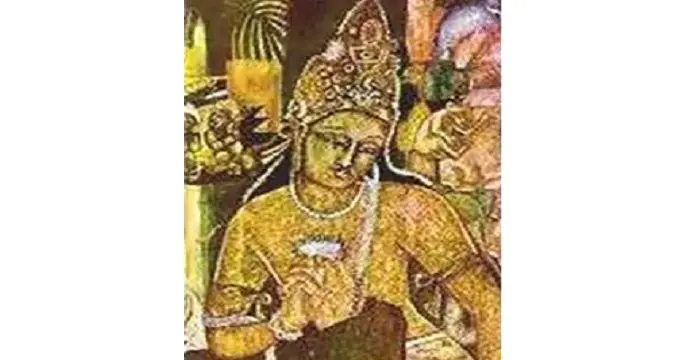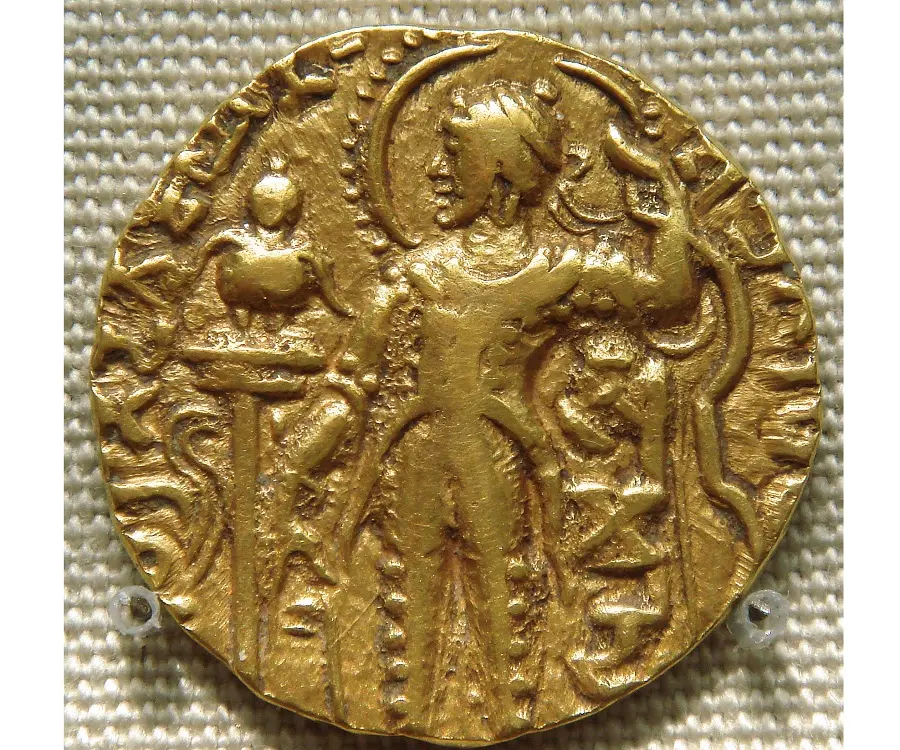
Samudragupta - Ruler of the Gupta Empire, Life Achievements and Family
Samudragupta's Personal Details
Samudragupta was the second ruler of the Gupta Dynasty
| Information | Detail |
|---|---|
| Birthday | 335 |
| Died on | January 1, 380 |
| Nationality | Indian |
| Famous | Historical Personalities, Emperors & Kings, Emperors, Kings, Ruler of the Gupta Empire |
| Childrens | Chandragupta II, Ramagupta |
| Religion | Hinduism |
| Gender | Male |
| Father | Chandragupta I |
| Famous as | Ruler of the Gupta Empire |
| Died at Age | 45 |
// Famous Kings
Sundiata Keita
Sundiata Keita was the founder of the Mali Empire in West Africa. This biography profiles his childhood, early life, struggles, founding of empire, rule, administration, achievements and also gives some fun facts.
Ashoka
Ashoka was the third emperor of the Mauryan Dynasty and ruled almost the entire Indian subcontinent. This biography profiles his childhood, life, reign, achievements and timeline
Murad IV
Murad IV was one of the mighty Sultans in the history of the Ottoman Empire. This biography profiles his childhood, family, accession, rule, administration and timeline.
Samudragupta's photo
Who is Samudragupta?
Samudragupta, the second emperor of the imperial Gupta Dynasty, was one of the greatest monarchs in the Indian history. Besides being a great warrior, a determined conqueror and a generous ruler, he was also a devoted fan of arts and culture, particularly poetry and music. While conquering different parts of India to extend his empire, he administered different policies for the northern and southern parts of India – while he ruled the upper parts under his direct control, the south, frontier states and tribal territories were permitted autonomy and freedom, though with a definite influence on them. He is regarded as the greatest ruler of the Gupta Dynasty with several western scholars terming him as the ‘Indian Napoleon’, largely due to his numerous military conquests to expand his empire. While Ashoka pledged never to war again after the Battle of Kalinga, Samudragupta, on the other hand, continued to capture states and territories to build a vast Indian military empire, which became one of the greatest kingdoms in the history of ancient Indian civilization. Details of his extensive reign and various conquests can be found engraved on gold coins and rock edicts
Childhood & Early Life
Samudragupta was born as the son of King Chandragupta I, founder of the Gupta Dynasty, and his Licchavi princess, Kumaradevi.
He was declared the next ruler of the Gupta Dynasty by his father a few years before the latter’s death. However, the decision was not accepted by the rivals to the throne and hence, led to a struggle, which Samudragupta ultimately won.
Accession & Reign
He ascended the throne as the second emperor of the Gupta Dynasty in 335 AD and began his journey of invading the neighboring kingdoms to increase his influence and conquer as many parts of India as possible.
To start off with, he succeeded in sujugating his immediate neighbors – Achyuta Naga from Ahichchatra, Naga Sena from Padmavati and Ganapati Naga from Mathura, marking his victory over the three major northern powers.
He restored southern kings as tributary kings after defeating them, thereby becoming a real statesman and adopted the ‘Dharma Vijaya’ policy as against the ‘Digvijaya’ prevailing in the north.
Since the southern kings were given their authority and supremacy to rule their kingdoms, he shifted complete focus on expanding his empire in the north, following which his second northern campaign began.
The war, which started for the control the northern basin, stretching from present-Allahabad to the borders of Bengal, ended with the entire Ganges Valley, Assam, Nepal, and parts of east Bengal, Punjab, and Rajasthan falling into his kitty.
By turning victorious in all his campaigns, he succeeded in becoming the master of a major portion of the Aryavata, meaning ‘land between the Himalayas and the Vindyas and between the western and eastern seas’.
Determined to establish his control over remote forest kingdoms as well, which were ruled by tribes, existing largely in Central India, he conquered all the 18 forest kingdoms, reinstating the chiefs as serfs or Puricharikas.
Such was the impact of his supremacy and fearsome rule that the rulers of the neighboring states, especially the Kushana rulers in the Kabul valley and Saka rulers in the far north-west, willingly agreed to pay him taxes in-person.
The neighboring states included both monarchical and republican on the frontiers – Samatata, Devaka, Nepal, Kartripura, Kamarupa, Malavas, Yaudheyas, Abhiras, Kakas, Arjunayanas, Sanakanikas, Prarjunas, and Madrakas.
His control over most of the northern India, right from Punjab to Assam dominated his authority over the Indo-Gangetic Valley with tributary power granted to frontier states and southern districts.
Although he was a devoted follower of Brahmanism, but he had high respect for other religions as well, which is evident from his permission to build a Buddhist monastery at Bodh Gaya by the Buddhist king of Ceylon, Meghavarna, in 330 AD.
He had high respect for learning and hence, employed numerous poets and scholars in his court. He had great interest in music too and was believed to be excellent at playing the lyre or veena.
Most important sources of his reign and conquests are his inscriptions on gold coins and inscriptions on rock edicts, especially the inscription on the rock edict (Ashoka pillar) at Allahabad, composed by his court poet, Harisena.
Major Battles
While embarking on his southern campaign, he traveled along the Bay of Bengal conquering 12 princes in the districts of coastal Odisha, Godavari, Ganjam, Vishakhapatnam, Nellore, Krishna and reaching as far as Kancheepuram.
He defeated and extinguished the kingdoms of nine kings, namely, Matila, Nagadatta, Ganapati Naga, Nandin, Rudradeva, Balavarman, Naga Sena, and Achyuta, and subjugated 12 more in Aryavata to increase the extent of the Gupta Empire.
Achievements
The number and type of coins prevalent during a particular reign throws a lot of light on the prevailing economic condition of the empire. Samudragupta started the monetary system and introduced seven types of coins – the Standard Type, the Archer Type, the Battle Axe Type, the Ashvamedha Type, the Tiger Slayer Type, the King and Queen Type, and the Lyre Player Type.
He was successful in creating a vast empire under his direct control, which extended from Jamuna and Chambal in the west to Brahmaputra in the east and Himalaya foothills in the north to Narmada River in the south.
Although he was a devoted follower of Brahmanism, but he had high respect for other religions as well. It is evident from his permission to build a Buddhist monastery at Bodh Gaya by the Buddhist king of Ceylon, Meghavarna, in 330 AD.
By patronizing research and inventions in religious, artistic, astronomy, science, dialectic, and literary aspects of the Hindu culture, he played a major role in further extending the Gupta Empire, known as the Golden Age of India.
Personal Life & Legacy
He was married to Dattadevi.
He ruled the Gupta Dynasty till his death in 380 AD and was succeeded by his son, Chandragupta II, also known as Vikramaditya, under whom the Empire continued to prosper and flourish.
// Famous Emperors
Sundiata Keita
Sundiata Keita was the founder of the Mali Empire in West Africa. This biography profiles his childhood, early life, struggles, founding of empire, rule, administration, achievements and also gives some fun facts.
Ashoka
Ashoka was the third emperor of the Mauryan Dynasty and ruled almost the entire Indian subcontinent. This biography profiles his childhood, life, reign, achievements and timeline
Murad IV
Murad IV was one of the mighty Sultans in the history of the Ottoman Empire. This biography profiles his childhood, family, accession, rule, administration and timeline.
Samudragupta biography timelines
- // 330Although he was a devoted follower of Brahmanism, but he had high respect for other religions as well, which is evident from his permission to build a Buddhist monastery at Bodh Gaya by the Buddhist king of Ceylon, Meghavarna, in 330 AD.
- // 330Although he was a devoted follower of Brahmanism, but he had high respect for other religions as well. It is evident from his permission to build a Buddhist monastery at Bodh Gaya by the Buddhist king of Ceylon, Meghavarna, in 330 AD.
- // 335Samudragupta was born as the son of King Chandragupta I, founder of the Gupta Dynasty, and his Licchavi princess, Kumaradevi.
- // 335He ascended the throne as the second emperor of the Gupta Dynasty in 335 AD and began his journey of invading the neighboring kingdoms to increase his influence and conquer as many parts of India as possible.
- // 380He ruled the Gupta Dynasty till his death in 380 AD and was succeeded by his son, Chandragupta II, also known as Vikramaditya, under whom the Empire continued to prosper and flourish.
// Famous Historical Personalities
Sundiata Keita
Sundiata Keita was the founder of the Mali Empire in West Africa. This biography profiles his childhood, early life, struggles, founding of empire, rule, administration, achievements and also gives some fun facts.
Ashoka
Ashoka was the third emperor of the Mauryan Dynasty and ruled almost the entire Indian subcontinent. This biography profiles his childhood, life, reign, achievements and timeline
Jetsun Pema
Jetsun Pema is the Queen consort of Bhutan. Check out this biography to know about her childhood, family life, achievements and fun facts about her life.
Murad IV
Murad IV was one of the mighty Sultans in the history of the Ottoman Empire. This biography profiles his childhood, family, accession, rule, administration and timeline.
Xerxes I
Xerxes I (Xerxes the Great) was the fourth and the most famous king of the Archaemenid dynasty of Persia. This biography profiles his childhood, family, personal life, life history, achievements, campaigns, administration, death and other facts.
Sargon of Akkad
Sargon of Akkad, also called ‘Sargon the Great’, ‘Sarru-Kan’ and ‘Shar-Gani-Sharri’, was the founder and first king of the Akkadian Empire. This biography profiles his childhood, life, rule, administration, timeline, and gives some fun facts.
Samudragupta's FAQ
When was Samudragupta died?
Samudragupta was died at 0380-01-01
Which age was Samudragupta died?
Samudragupta was died at age 45
What is Samudragupta nationalities?
Samudragupta's nationalities is Indian
Who is Samudragupta childrens?
Samudragupta's childrens is Chandragupta II, Ramagupta
What is Samudragupta's religion?
Samudragupta's religion is Hinduism
Who is Samudragupta's father?
Samudragupta's father is Chandragupta I
How famous is Samudragupta?
Samudragupta is famouse as Ruler of the Gupta Empire






